#stone bowl bibimbap
Text
youtube
Bibimbap
비빔밥
Rice mixed with vegetables, meat, an egg, and chili pepper paste
Today’s recipe is bibimbap, a super-popular Korean dish you might have heard about already! It’s made of a bowl of rice, sautéed and seasoned vegetables (namul: 나물), a bit of hot pepper paste (gochujang: 고추장), and usually a bit of seasoned raw beef, too (yukhoe: 육회).
Bibim (비빔) translates as “mixed,” and bap (밥) means “cooked rice,” so bibimbap literally means “mixed rice.” Before eating it you’re supposed to mix everything all together.
There are many variations on this dish, from simple to elaborate, and this recipe I’m showing you today is for one you could consider “classic” bibimbap. If you ordered bibimbap in a Korean restaurant, you would probably get something like this dish, with regional variations. I’m also going to show you bibimbap prepared and served in a heated stone or earthenware bowl called dolsot-bibimbap (돌솥비빔밥). “Dolsot” means “stone pot” in Korean, and this version is well-known for the way the bowl makes a layer of crispy, crackling rice on the bottom of the bibimbap.
Even though we mix up bibimbap before we eat it, each ingredient needs to be prepared with care and individuality, bringing out their unique flavors, textures and colors so they come together beautifully in the bowl and deliciously in your mouth. The different ingredients aren’t random, they’re chosen because they balance, harmonize, and offset each other.
This recipe isn’t quick and easy, it takes some time to make. But if you’re really in a rush you can make a great bibimbap with the soybean sprouts, spinach, and carrot (or red bell pepper, or both), and gochujang, toasted sesame oil, and an egg— those items are unskippable!
I’m going to share some more bibimbap recipes on my website in the future, and you’ll see how many different variations there are. This version is a little different than the version in my cookbook, because I make a quick and simple soup with the bean sprouts. When I started my YouTube channel, bibimbap was one of the first recipes I made, because it’s such an essential dish in Korean cuisine. So I’m happy to remake the video now in HD with much better editing and instruction. I’ve been building up to this video by remaking videos for the ingredients, too. I remade yukhoe, and sigeumchi-namul, and my yukagaejang video has a lot of detail about preparing the mountain vegetable fernbrake.
So if you’ve been following my videos, you’re now ready to be a bibimbap master! Ready? Let’s start!
Ingredients (serves 4)
5 cups cooked short-grain rice
12 ounces soy bean sprouts, washed and drained
8 ounces of spinach blanched and washed with the excess water squeezed out by hand
1 large carrot
1 large red bell pepper
1 large zucchini
1 English cucumber
3 to 4 green onions, chopped
½ pound fresh lean cut of beef (fillet mignon, flank steak)
4 ounces fernbrake (gosari), fresh or soaked from ½ ounce dried gosari (details below)
1 ounce dried bellflower roots (doraji), soaked in cold water for 18 to 24 hours.
4 eggs
kosher salt
vegetable oil
toasted sesame oil
toasted sesame seeds
garlic
soy sauce
honey (or sugar)
Korean hot pepper paste (gochujang)
How to prepare dried fernbrake (gosari) for use
If you have presoaked or fresh fernbrake you can use it straight away, but if you have dried fernbrake you’ll need to get it ready to eat. It’s fast if you have a pressure cooker, but if you don’t it will take some time.
With a pressure cooker:
Wash ½ ounce of dried gosari and boil it with 5 cups of water in a pressure cooker for 30 minutes.
Drain and rinse in cold water a couple of times.
Drain. It should make 4 ounces.
In a pot on the stove:
In a large saucepan add ½ ounce of dried gosari to 7 cups of water. Bring to a boil over medium-high heat and boil for 30 minutes. Cover and let stand until cool, about 2 to 3 hours.
Rinse the fernbrake a couple of times, drain and put in a bowl. Cover with fresh cold water and let soak for at least 8 hours or overnight in a cool place, changing the water 2 or 3 times during the soaking.
Taste the gosari: It should be soft. If it’s tough, boil it again in a fresh pot of water for about 20 minutes and then let it sit, covered, until soft.
Drain. It should make 4 ounces.
Make rice
If you have a usual method for making rice or have a rice cooker, go ahead and make 5 cups of rice like you usually do. But here’s how I do it on a pot on the stove. 2 cups of dried rice makes about 5 cups of cooked rice.
Rinse 2 cups of rice in cold water and scrub the wet rice with your hand. Rinse and drain until the drained water is pretty clear.
Put the rice in a heavy-bottomed pot. Add 2 cups of water, cover, and soak for 30 minutes.
Cook over medium high heat for 7 to 8 minutes until the surface is covered with abundant bubbles that are spluttering noisily and look like they’re about to overflow the pot. Turn the rice over a few times with a spoon and cover the pot again.
Turn the heat to very low and simmer for another 10 minutes until the rice is fully cooked and fluffy. Remove from the heat.
Fluff the rice with a spoon to release excess steam. Let the rice stand, covered, at room temperature to keep it warm.
Prepare and cook the ingredients for bibimbap
I like to get a big platter and then put each vegetable on it as they’re ready. I think it looks really pretty, but you don’t have to do this. When all vegetables are prepared and ready to use, the platter looks pretty delicious!
Soybean sprouts:
Put the soy bean sprouts in a pot and add 4 cups water and 2 or 3 teaspoons salt. Cover and cook for 20 minutes over medium high heat. Take out the sprouts with tongs and put them into a bowl, leaving about ½ cup of sprouts in the pot with the water you used to boil them. This is the soup to serve with bibimbap later.
In a bowl, mix the sprouts by hand with ½ teaspoons salt, 1 teaspoon minced garlic, and 2 teaspoons toasted sesame oil. Put them on the large platter.
Spinach:
Cut up the blanched spinach a few times and put it in a bowl. Mix by hand with 1 teaspoon garlic, 1 teaspoon toasted sesame oil, ½ teaspoon kosher salt, and 1 teaspoon sesame seeds. Cover and put it next to the soy bean sprouts on the platter.
Other fresh vegetables:
Cut the carrot into matchsticks, put them in a bowl, and mix with a pinch of salt. Let stand for 5 to 10 minutes until sweating.
Cut the red bell pepper into halves, deseed, and slice into strips. Put them in a bowl.
Cut the zucchini into matchsticks and mix with ½ teaspoon kosher salt.
Cut the cucumber into halves lengthwise and slice thinly crosswise. Mix with ¼ teaspoon kosher salt.
Beef:
Cut the beef into matchsticks and put them in a bowl.
Mix with 1 tablespoon minced garlic, 1 tablespoon soy sauce, 1 tablespoon honey, 2 teaspoons toasted sesame oil, and 1 teaspoon sesame seeds with a spoon.
Cover and keep in the fridge until ready to use.
Mountain vegetables:
Cut the fernbrake (gosari) a few times into bite size pieces. Set aside.
Put the bellflower roots (doraji) in a large bowl. Add 1 or 2 tablespoons salt. Rub for a minute to wilt slightly and release some of the bitterness. Rinse them in cold water a couple of times and drain. If you find some roots are too thick, split them lengthwise. Set aside.
Let’s cook!
Heat up a pan over medium high heat. Squeeze out excess water from the carrot. Add a few drops of cooking oil to the pan and sauté the carrot for 1 minute. Put it on the platter next to the soy bean sprouts and spinach. Clean the pan with wet paper towel or wash it.
Heat a few drops of cooking oil in the pan and squeeze out the excess water from the cucumber. Sauté with ½ teaspoon minced garlic and a few drops of toasted sesame oil for 30 seconds. Put it on the platter. Clean the pan.
Heat up the pan with a few drops of cooking oil. Add the red bell pepper and sprinkle a pinch of salt over top. Sauté for 30 seconds. Put it on the platter. Clean the pan.
Heat up the pan and squeeze out excess water from the zucchini. Add a few drops of cooking oil and sauté with 1 teaspoon minced garlic, 1 tablespoon chopped green onion, a drop of toasted sesame oil for 1 minute until slightly softened. Put it on the platter. Clean the pan.
Heat up the pan with a few drops of cooking oil. Add the bellflower roots and sauté for 2 to 3 minutes. Lower the heat to medium so as not to brown them. Add 1 teaspoon minced garlic and a drop of toasted sesame oil. Stir for another minute until a little softened. Put it on the platter. Clean the pan.
Heat up the pan. Add a few drops of cooking oil. Stir the gosari for 2 minutes until a little softened. Add ½ teaspoon of minced garlic, 2 teaspoons soy sauce, and 2 teaspoons sugar, and keep stirring for another minute. Put it on the platter.
Serve
Here are a couple of ways to serve: bibimbap in a regular, shallow bowl, and dolsot-bibimbap in a stone or earthenware bowl.
In a regular, shallow bowl
Reheat the soybean sprout soup.
Divide the cooked rice into 4 portions. Each portion will be a little more than 1 cup of rice.
Put the rice in each of 4 bowls and arrange the vegetables and beef on the rice. Top with a raw egg yolk and gochujang. If you prefer your eggs and beef cooked, use a fried egg sunny side up and slightly pan-fry the beef before putting them on the top of rice.
Sprinkle the bibimbap with the sesame seeds and drizzle with sesame oil to taste.
Ladle the soup to a small bowl and sprinkle some chopped green onion over top.
Serve right away with more hot pepper paste on the side, and maybe kimchi too.
Dolsot-bibimbap in a hot earthenware bowl (ttukbaegi) or hot stone bowl (dolsot)
Reheat the soybean sprout soup.
Put a few drops of toasted sesame oil in the bottom of each of 4 earthenware bowls. They should be big enough to hold 4 to 6 cups each.
Divide the rice among the bowls. Arrange the vegetables and beef on the rice. Top each serving with a raw egg yolk and 1 tablespoon gochujang. If you prefer your eggs and beef cooked, use a fried egg sunny side up and slightly pan-fry the beef before putting them on the top of rice.
Set each pot on a burner. Heat over medium high heat until you hear a ticking, crackling sound coming from the rice.
Sprinkle the bibimbap with the sesame seeds, drizzle with sesame oil to taste.
Ladle the soup to a small bowl and sprinkle some chopped green onion over top.
Serve right away with more hot pepper paste on the side and maybe kimchi too.
Eat
Gently but firmly mix everything together in the bowl with your spoon. Try not to crush the more delicate ingredients.
Eat with your spoon.
Posted on Sunday, January 6th, 2008 at 11:14 pm. Last updated on September 18, 2022.
#bibimbap#bibimbap recipe#dolsot bibimbap#돌솥비빔밥#비빔밥#homemade bibimbap#hot stone bowl bibimbap#how to eat bibimbap#how to make bibimbap#how to make dolsot bibimbap#Korean earthenware bowl bibimbap#korean food#Korean Mixed Rice with Meat and Assorted vegetables#Korean mixed rice with vegetables and meat#Korean recipes#Korean stone pot bibimbap#rice mixed with vegetables#spicy mixed rice#stone bowl bibimbap#Youtube#kfood#korean#food#foodie#recipe#bts#rm#jin#suga#jhope
5 notes
·
View notes
Photo




While Kit Kat may have slowed down production of new and experimental flavors of late, Cup Noodle seems to have stepped it up as I found interesting options hitting shelves in both Japan and Singapore on my last trip. The first one I tried upon coming home was “Cup Noodle Hot Stone Bibimbap: Sweet & Sour Gochujang Flavor”, which, unfortunately, was really nothing special. Could have achieved the same flavor profile, and maybe more heat, by adding a tablespoon of actual gochujang into a normal Cup Noodle. The chunks of beef and pieces of kimchi you see in the pic there were non-existent. A swing and miss for Nissin on this one, IMO.
#japan#japanese#cup noodle#instant noodles#ramen#cup ramen#instant ramen#korean#bibimbap#stone bowl#gochujang#hot pepper#spicy#spice#noodles#beef#kimchi#limited edition#convenience store#conbini#food#foodie#travel
32 notes
·
View notes
Text
(CW: LOTS OF JOYFUL YELLING)
I LOVE OUR DINING TABLE, I LOVE IT I LOVE IT I LOVE IT! I LOOOOOVVVVEEE ITTTTTTTTTTT.
We’re already getting into GOOD Kinou Nani Tabeta/great pace/lovely softness/all the emotions/fabulous food shots territory! Flashbacks! Little kids! Lots of ma! Longing shots of dudes!
Fuck yes. God damn it, I am so, SO happy TBS adapted this manga.
(Before I go on, I must implore any of you who have the time to PLEASE read this manga. It’s only one volume, beautifully translated, and I think the dorama is going to hew close to the story — at least, this first episode did. It is SUCH a fabulous read.)
I don’t have the moments to write a whole deep thing, but let me continue to list what I loved about this show and what I hope they’ll dive into more:
1) RICE! Y'all know I love rice, and I ESPECIALLY LOVE SHOWS that feature rice as a humble but potent character. (Oh, how I miss you, Moonlight Chicken.)
Onigiri is the humblest of foods, but also so beloved. (Onigiri can actually be a little difficult to make, as depicted in the Kinou Nani Tabeta manga -- if you place the hot rice on your bare hands, you salt your hands in advance and prepare for some owies.)
So about the rice: making rice in a nabe takes legit skill. I've burnt rice in a nabe before, as I'm really only used to using a rice cooker, but: rice out of a nabe is DEFINITELY special, because of the ability to make a crunchy bottom layer of rice at the end. If you can balance the timing just right, that crunchy layer adds so much depth and flavor to the rice. (I got this to make nabe rice at home, and you really need to use proper Japanese short-grain rice to get the best result, in my own opinion as a home cook -- but I'd love to learn tricks from others on how to use this pot for other types of rice, as I'm not skilled enough yet to do that.)
One more point about crunchy/crispy rice: it's beloved across Asia/Eurasia/the Middle East. Persian tahdig, Korean nurungji and dolsot bibimbap (when you order a dolsot bibimbap, mix everything as fast as you can and smush the rice against the hot stone bowl, then let it CHILL for a couple minutes -- then scrape it all off and mix the crunchy rice in with all your bibimbap stuff and AAAAHHHH SO GOOD), all the peeps love it.
So Minoru and Tane getting excited about all the different aspects of nabe rice is so meaningful (the crunchy layer, the middle part of the rice), because honestly -- eating nabe rice means that you're at HOME, and someone at HOME knows how to make this humble food so well. Sitting around a nabe, whether it's filled with rice or a stew, means that you're likely sitting around a table with people you love, eating together. Our Dining Table takes this motif right out of the batting cage and hits a home run with it. (@respectthepetty, I'm goin' off on the food again, natch.) Sigh. All of this makes me so happy. And there's so much more food to look forward to in the show.
2) I love that the yellow smiley face motif is taking a flight from Thailand to Japan. This means a lot if you know Yutaka's backstory already.
3) I think the dorama is going to make me appreciate this even more than the manga, but it's a hell of a lot of work to take care of a little kid, lol. Seeing Minoru grabbing Tane when Tane first met Yutaka, it gave me the mom feels. This is also a really important point to this story, but -- visually seeing Minoru struggle automatically made me understand his character even more.
GIVE ME MORE OF THIS SHOW! Y'all, it's already so great, and it's going to get better. All of the emojis, all of them. I'm meeping so hard!
#our dining table#bokura no shokutaku#mita ori#yutaka x minoru#minoru x yutaka#tane-kun is the CUTEST CUTEST character EVER#roadtrip posts
35 notes
·
View notes
Text
“Miss Tokki? She isn’t from here, but it seems like she really enjoys it as a medic for the Forest Rangers. Also, she cares for me a lot just like Master Tighnari.”
- Collei
🐇 Name: Tokki
🐇 Title: Nurturing Remedy
🐇 Second-in-Command of the Forest Rangers
🐇 Vision: Geo
🐇 Constellation: Cuniculus Lunaris

--
Hangul: 토끼
Vision: Geo
Weapon: Polearm
Birthday: September 17
Constellation: Cuniculus Lunaris
Region: Sumeru; Gangcheol* (Formerly)
Affiliation(s): Forest Watchers; Dal-i Tteuneun Court* (Formerly)
Special Dish: Bibimbap - Stone Bowl Surprise
--
Ascension Materials
Gem: Prithiva Topaz
Boss Drop: Earthshaking Root (Geo Regisvine)*
Local Specialty: Mugung Rose*
Enemy Drop: Concealed Claw/Unguis/Talon (Rifthound)
Talents
Normal Attack: Guardian Lance
Normal Attack
Performs up to 5 consecutive spear strikes.
Charged Attack
Consumes a certain amount of Stamina to lunge forward, dealing damage to opponents along the way.
Plunging Attack
Plunges from mid-air to strike the ground below, damaging opponents along the path and dealing AoE DMG upon impact.
Elemental Skill: Rabbit Rush
When activated, Tokki and nearby allies gain a brief burst of incredible agility, increasing Movement SPD by 10%.
Tap
Quickly dashes forward a certain distance.
Hold
Sprints around continuously, allowing Tokki and affected allies increased Movement SPD and slightly increased interruption resistance.
This skill has a maximum duration of 10s and enters a CD period equal to the length of the run.
Elemental Burst: Dal’s Splendor
Spears the ground to generate a Geo AoE that regenerates HP over time.
While active, Dal’s Splendor interacts with the surrounding environment. If cast near a Geo Construct, the AoE’s healing is amplified, and it periodically releases bursts of energy that deals Geo DMG to nearby enemies.
The HP regeneration and Geo DMG bursts are increased at night (18:00 - 6:00) by 20%.
1st Ascension Passive: Lunar Blessing
When attacking while under the effects of Rabbit Rush, increased 50% chance to generate Elemental Particles.
4th Ascension Passive: Crystalline Resolve
Tokki gains a 20% Geo DMG Bonus.
Utility Passive: Rejuvenating Haste
When Tokki cooks a dish with restorative effects perfectly, she has a 12% chance to receive double the product.
Talent Materials
Enemy Drop: Concealed Claw/Unguis/Talon (Rifthound)
Talent Book: Praxis (Domain of Mastery: Basket of Discipline)
Boss Drop: Mirror of Mushin (Everlasting Lord of Arcane Wisdom)
*These are my fan-made Genshin content.
#michi’s oc collection#tokki 🐇#gangcheol is genshin korea#i may post background info on my concepts later#genshin oc#genshin impact oc#tokki genshin#tokki genshin impact#genshin impact
3 notes
·
View notes
Note
what kind of stuff do you like on bibimbap?
For at home bibimbap I like fresh spinach, zucchini, bean sprouts, shredded carrot, and shiitake mushrooms. If I'm feeling fancy I like to make some pork bulgogi to go with it too.
But my all time favorite was a hot stone bowl squid bibimbap that I used to be able to get at a Korean supermarket called H Mart. The hot stone bowl crisped the rice at the bottom making it sweeter and crunchier, and the squid was as tender as it was delicious.
That food court had an overhaul and ever since they no longer sell squid bibimbap. Maybe it's a sign that I should start trying to replicate it myself.
8 notes
·
View notes
Text
applepi00
9 people you would like to get to know better
Tagged by @applepi00, thanks!
3 ships:
HakkaixGojyo (TenpouxKenren) - Saiyuki. What can I say? They're the Fated Guys. How can you not love this pairing, this ship dynamic? The fussy schoolteacher and the chainsmoking playboy find each other in a world gone chaotic in the shadow of the apocalypse. They were my first real, true, I'mma-write-fic-about-this ship. They've spent 500 years finding each other. Tough to beat.
Sokouku - Bungou Stray Dogs. Naturally, skk has to be on the list, right? Irresistible! I love a love affair that comes with a smack in the chops for good measure. Anyway, I'm a sucker for that kind of unequivocal trust, even when it's covered in idiocy.
MikoRei - K. Remember what I said about a smack in the chops? Well, MikotRei's got it. Their braincells are allergic to each other. They're deeply dippy about each other, and mad about it. Also, cue me up for that fucking tragedy and angst, yo. We've never written a single fic for this pairing, but we have hundreds of thousand of words of RP to Fix It.
Last Song: Details Kill by Juliet Ruin. This is one of my sister's bands (listen, they actually do kick ass, you should look them up on spotify or youtube or wev), and since we just went to a live show last night, I'm grooving. Personal favourite song by JR is Fight to Win, but this is the last one that I was listening to today.
Last Movie: Went to see the 1970s Bollywood movie Don a couple of weeks back. It was a good time!
Currently Reading: A shit ton of literature coming out of the Global War on Terror, actually. Good ones have been Home Fire by Kamila Shamsie, Look: Poems by Solmaz Sharif, and The Corpse Exhibition by Hassan Blasim. A ton of literary theory relating to the mechanical image. Grad school's wild.
Currently Watching: Nearing the end of a rewatch of Alchemy of Souls.
Currently Craving: BIBIMBAP. In the stone bowl, so takeout's not going to cut it, unfortunately. Lots of gochujang. I waaaaaaant.
I'mma just tag everyone who wants to do the thing, 'cause I just don't have that many moots, lol
2 notes
·
View notes
Note
Oh my did you go to the Korean Stone Bowl Grill in Milwaukee?! (I saw your post on Twitter) I've tried the bibimbap there once and it was so good! I wish I could go to one of these cons to buy a turtle tot plush from you.
I had another question about the turtle tots plush patterns. I know you said you use an embroidery machine, and I looked and those are like $1000! Oof. Is the turtle tot embroidery something that can be done by hand, do you think? Or painstakingly with a regular machine? In your very professional opinion of course :)
I hope you're having a nice and successful time at all these cons!
I did go there! It was amazing! I want to go back! XD
I’ve seen people do embroidery by hand before. It does take a while though. Alt methods can be done too like appliqué, fabric paint, or iron on transfers.
15 notes
·
View notes
Text
[Download PDF/Epub] My Korea: Traditional Flavors, Modern Recipes - Hooni Kim
Download Or Read PDF My Korea: Traditional Flavors, Modern Recipes - Hooni Kim Free Full Pages Online With Audiobook.

[*] Download PDF Here => My Korea: Traditional Flavors, Modern Recipes
[*] Read PDF Here => My Korea: Traditional Flavors, Modern Recipes
Simple rice cakes drenched in a spicy sauce. Bulgogi sliders. A scallion pancake (pajeon) the New York Times calls ?the essential taste of Korean cuisine.? For years Hooni Kim?s food has earned him raves, including a Michelin Star?the first ever awarded to a Korean restaurant?for Danji. His background in world-class French and Japanese kitchens seamlessly combines with his knowledge of the techniques of traditional Korean cuisine to create uniquely flavorful dishes.My Korea, his long-awaited debut cookbook, introduces home cooks to the Korean culinary trinity: doenjang, ganjang, and gochujang (fermented soybean paste, soy sauce, and fermented red chili paste). These key ingredients add a savory depth and flavor to the 90 recipes that follow, from banchan to robust stews. His kimchis call upon the best ingredients and balance a meal with a salty, sour, and spicy kick. Elevated classics include one-bowl meals like Dolsot Bibimbap (Sizzling-Hot Stone Bowl Bibimbap), Haemul Sundubu
2 notes
·
View notes
Text

돌솥 비빔밥 or dolsot bibimbap, from a local Japanese/Korean restaurant. This version of 비빔밥 is served in a hot stone bowl that is coated with sesame oil prior to adding the rice, crisping up the bottom layer of rice and contributing an umami, nutty flavor.
비빔밥 is a dish that has been eaten in Korea for centuries. Believed by some to originate from a need to use up the excess 반찬 (banchan, or vegetable side dishes) by the end of the year, 비빔밥 combines a variety of colorful vegetables in a bowl with rice. Meat and eggs are popular additions to this recipe.
The ingredients are separated upon plating, but are intended to be mixed together just prior to consumption. I took the liberty of adding 고추장 (red chili paste) to mine.
Morgantown, West Virginia—January 20, 2024
0 notes
Text
Bibimbap
INGREDIENTS
BEEF BULGOGI
250 g beef, sliced into strips
2-3 garlic cloves, minced
2 tbsp soy sauce
1 tbsp sugar
1 tbsp sesame oil
Black pepper
If you’re vegetarian, replace the meat with tofu or just use more mushrooms!
SAUCE
2 tbsp gochujang (Korean red pepper paste)
1 tbsp sugar
1 tbsp garlic, minced
1 tbsp sesame oil
2 tsp sesame seeds, optional
OTHER INGREDIENTS
400 g cooked rice, preferably short-grain
1 carrot, peeled and julienned
1 zucchini, julienned
2 handfuls spinach
1 handful bean sprouts
5 large shiitake mushrooms, sliced
2 eggs, fried
Sesame oil
Roasted seaweed, optional
Salt
INSTRUCTIONS
Cook your rice, if you haven’t already. This works well with leftover rice too.
Prepare beef: combine all the ingredients for the beef bulgogi in a bowl and leave to marinate while you prepare other ingredients.
Make sauce: mix together all the ingredients for the sauce and set aside
Prepare vegetables: In a pot of boiling water, blanch the bean sprouts and spinach separately and then dump the spinach in ice cold water to stop the cooking process and retain its colour. Squeeze the spinach of excess water and season with salt and sesame oil. Season the bean sprouts with salt and sesame oil as well.
In a pan with some sesame oil over medium heat, stir fry your carrot, zucchini, mushrooms separately until cooked through. Season to taste.
In the same pan, cook the marinated beef. Set aside
Assemble: there are 2 options – dolsot (making the rice crispy) or normal bibimbap.– Dolsot: brush your stone bowl with sesame oil and place some rice inside a bowl. Carefully arrange the vegetables, meat and mushrooms next to one another to cover up the rice. Place the sauce in the center and top a fried egg on top. Over medium heat, heat up your rice bowl for approximately 5-10 mins or until the rice on the bottom is nice and crispy. Crush roasted seaweed on top, mix and serve– Normal: Same as dolsot but without the sesame oil and heating process. Mix and serve immediately

Recipe and photo by: Lucie | butt.erhand
#Bibimbap#korean food#asian food#healthy eating#recipe#nutrition#gluten allergy#gluten free#vegan#vegetarian
0 notes
Text
Korean Flavors at Dookki in Alabang
DOOKKI is a Korean Restaurant in Alabang, Muntinlupa City. There are many hotels located around this amazing restaurant. Find out the website here @alabanghotels
Korean cuisine is known for its distinct flavors and rich variety of dishes. Here are some popular Korean foods:
Kimchi: A staple of Korean cuisine, kimchi is a fermented side dish made from vegetables like Napa cabbage, radish, or cucumber. It is seasoned with chili pepper, garlic, ginger, and other spices.
Bibimbap: A mixed rice dish topped with assorted vegetables, meat (usually beef or chicken), and a fried egg. It is served with gochujang (a spicy red chili paste) and mixed together before eating.
Bulgogi: Thinly sliced marinated beef that is grilled or stir-fried. The meat is typically tender and slightly sweet, thanks to a marinade made with soy sauce, sugar, garlic, sesame oil, and other ingredients.
Japchae: A stir-fried dish made with glass noodles made from sweet potato starch, various vegetables, and thinly sliced meat (optional). It is often seasoned with soy sauce and sesame oil.
Samgyeopsal: A popular Korean BBQ dish consisting of thick slices of pork belly, grilled at the table. It is often enjoyed by wrapping the meat in lettuce leaves, along with garlic, onions, and ssamjang (a spicy dipping sauce).
Tteokbokki: Spicy rice cakes cooked in a gochujang-based sauce. It is a popular street food in Korea and can sometimes be accompanied by fish cakes, vegetables, or boiled eggs.
Haemul Pajeon: A savory pancake made with a variety of seafood such as shrimp, squid, and clams, along with green onions and a batter of wheat flour and eggs.
Jjajangmyeon: A Chinese-Korean dish consisting of wheat noodles topped with a thick black bean sauce, stir-fried with diced pork or seafood and various vegetables.
Sundubu-jjigae: A spicy tofu stew made with soft tofu, vegetables, seafood, and/or meat. It is often served bubbling hot in a stone bowl and accompanied by rice and banchan (side dishes).
These are just a few examples of the many delicious dishes you can find in Korean cuisine. The emphasis on fresh ingredients, intense flavors, and communal sharing make Korean food a delight to try.
BEAUTIFUL THOUGHT FOR THE DAY:
Kindness is one thing you can’t give away. It always comes back. George Skolsky
0 notes
Text
crystal in korea part two: seoul
Following several fun days in Busan, my friends and I headed next for Seoul, South Korea's capital and biggest city.
After arriving by train, my friends and I went in search of lunch and found a place that serves bibimbap, a rice bowl topped with meat and vegetables. It was so delicious. Bibimbap is one of my favorite Korean foods and is available in many countries, so I highly reccommend trying it!
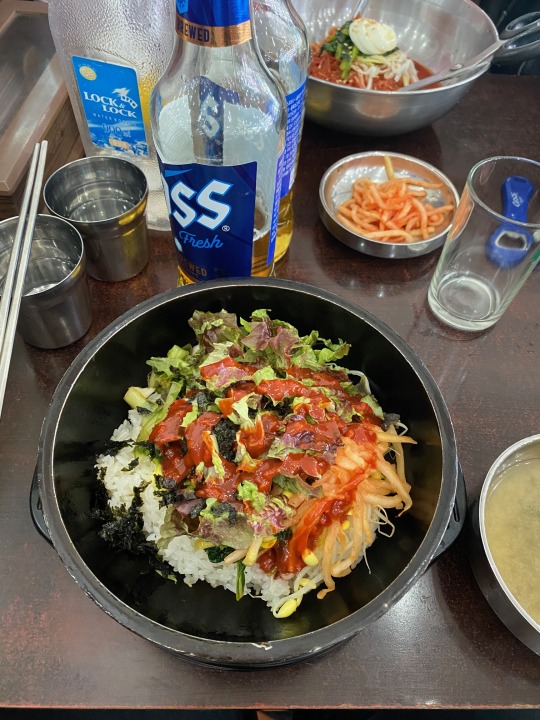
Next, we headed to a shopping district and I went to a small studio space to get a tattoo. Similar to Japan, tattooing in Korea is actually technically illegal, and most businesses operate "underground." Nevertheless, many younger Koreans have tattoos, and many people travel to country to receive tattoos there. There are many talented artists in Korea with distinct styles. I was tattooed by the artist Jalopy, whose Instagram can be found here. She specializes in stick and poke tattoos, and she can speak English really well. I got a tattoo of an umbrella to represent a poem written by my friend Al, who passed away several years ago. I'm grateful to Jalopy for doing such a great job, and I cherish this new addition to my body.

In the evening, a couple friends and I split off to the group to visit a large riverside park with a view of the cityscape. The park was filled with various stalls. Many of them sold food, but many also rented out blankets, mats, lights, and small tables to use for picnics. I've never seen anything like this in the US or Japan, and I thought it was such a great idea. Many people come to the park to picnic and enjoy the view, and it was a relaxing and fun way to spend the evening.
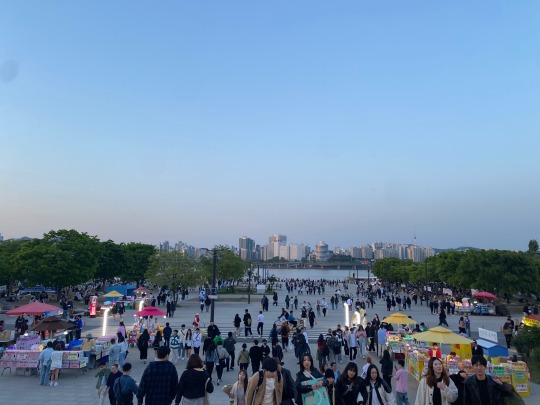

The next morning, we headed to Changdeokgung Palace, a huge palace grounds with traditional buildings and gardens. Nearby were many shops where you could don a hanbok, a traditional Korean dress, so a few of my friends did that and the dresses were so beautiful and elaborately decorated. It was a very popular attraction, so many girls wandered the palace grounds in traditional wear, and it really made the experience feel more authentic.

We walked around the palace grounds looking at the various buildings. Like the temples I had seen in Korea so far, the buildings were in a Chinese style, but painted with beautifully vibrant colors and designs.
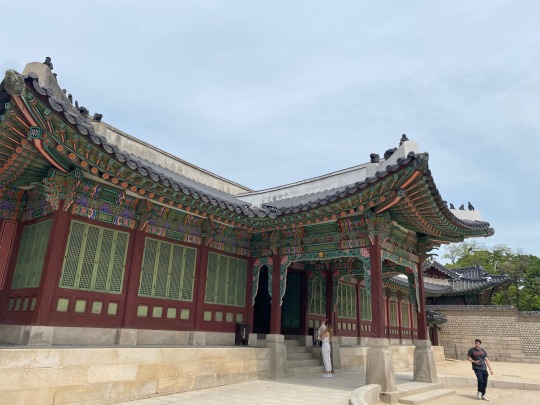
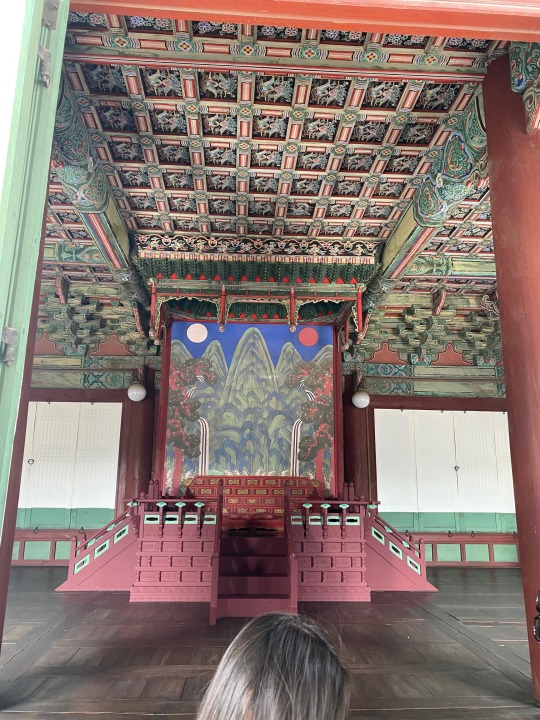

Next we walked to a nearby street lined with traditional old Korean homes called the Bukchon Hanbok Village. It was a bit of a steep hike up to it, and you could only really see the front gates, but the little neighborhood was still charming and lovely.
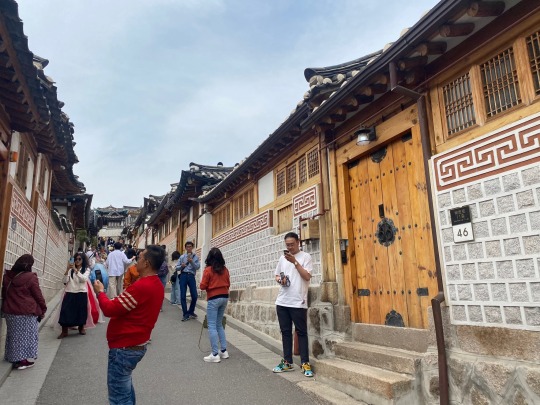
After that, we walked to another palace nearby called the Gyeongbokgung Palace. Since we had spent so much time at the other palace already, we decided to just look around the entrance at the gate and not pay the entrance fee to go in. But the entrance gates were huge and magnificent.

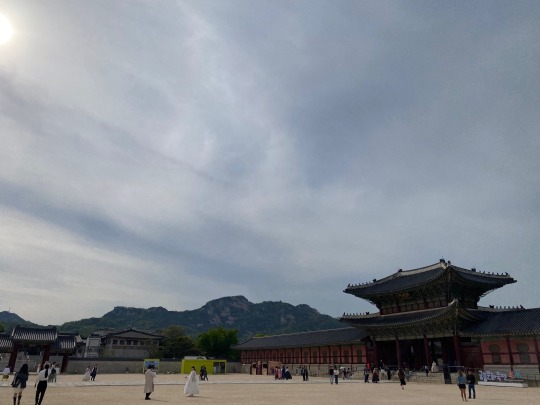
Next we headed to a small neighborhood known for its street art murals. I don't know how the murals came to be there, but there were so many of them and they were so beautiful.


We continued a bit further up the hill to Naksan Park to enjoy a beautiful view of the city over an old stone wall.

After this we were pretty hungry, so we found a restaurant where we could eat kimchi pancakes and rolled omelets filled with cheese, which were so delicious.


With that, we ended the day (actually just I did, everyone else wanted to go out drinking lol.)
The next morning I got up bright and early and left my friends to their alcolhol-induced slumbers to head to Bukhansan mountain for a hike. I'm so glad that Seoul has such a huge and flourishing green mountain so close to the city, since I'm not much of one for city travelling and was itching to get out into nature.

I think it was about 3 km up to the peak that I hiked to. I had originally planned to hike to a different peak, but since I'm not familiar with Korea's systems or the Korean language, I ended up taking a different trail than I originally planned.
The trail I ended up on was of course very beautiful nonetheless. For about the first kilometer, the trail was lined with colorful lanterns which led up to a shrine on the mountain. On the way up I passed a smaller shrine with no one around but a pudgy Buddha statue, whose belly I rubbed for luck and continued on.


A bit further up the mountain I started to hear the sounds of chanting drifting through the trees. It was really ethereal. I kept walking up the trail towards the sound and found myself at a shrine. The shrine was of course colorfully painted and I paid my respects and used their bathroom (a squat toilet and port-a-potty all in one, which was...unpleasant but nonetheless appreciated.) When I was walking through the woods, I had expected to come across a group of people chanting, but was surprised to find that nobody was around the the chanting was either prerecorded or being broadcast from a single monk through a microphone.

I continued on up the mountain. Eventually I came across a third shrine. This one was brilliantly and beautifully colored in shades of blue, and there was an unfriendly dog guarding the shrine that growled at me when I came near. There was a lookout spot from the shrine where you could look out and see the cityscape. It was really beautiful, and there was a refreshing breeze.

Leaving that shrine, I followed more trailhead signs until I came to a big ancient-looking gate. According to a sign nearby, there were about six gates surrounding the fortress of Bukhansan. At this point the trail continued past the gate heading downwards, but I had hiked over 3km up and had to meet with my friends again later, so I decided this was to be the peak of my hike. I climbed up to the top of the gate where there was a brilliant view of the city and took a rest, eating some gimbap that I brought with me from the convenience store. Here's me covered in sweat and hiking grime celebrating my successful hike:



After this, I retraced my steps back down the mountain to the park entrance. This hike was one of the highlights of my whole trip, and I really felt refreshed after despite the distance that I walked.
After my hike, I hopped on a bus back to the city center and met up with my friends at a shopping mall called Common Ground made out of big blue shipping containers, which was pretty cool.

As the day wound down, I stopped at a grocery store to grab some souvenirs for friends and coworkers back in Japan and my friend introduced my to corn ice cream which was...interesting. I didn't hate it.
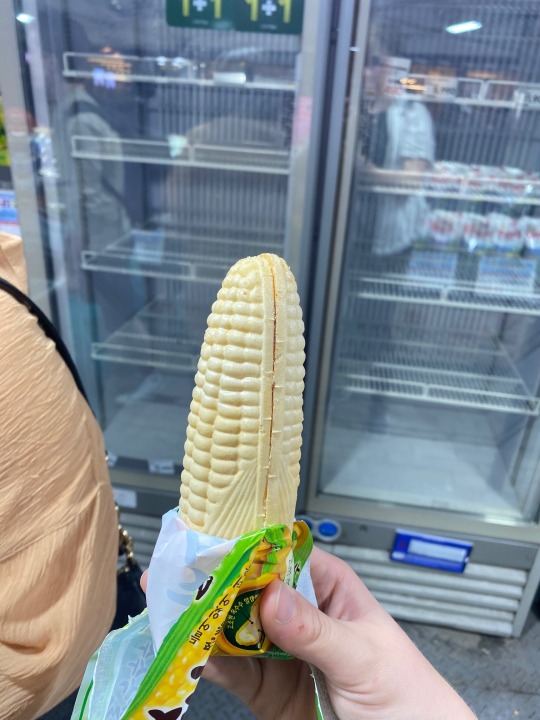
With that my last full day in Seoul came to a close.
The next morning before heading to the airport I made a short stop at the Korean National Museum on my own, eager to learn more about Korea's history and culture, since I honestly didn't know a lot.

The building was huge and magnificent, filled with countless priceless artifacts. And yet somehow the museum entry was free! I was so impressed and thankful to Korea for letting people have access to that knowledge for free. The most notable parts of the museum that I learned was that the traditional art of Korea seemed to have the same color schemes as the temples, with vibrant reds, greens, and blues. I also learned about their history of making celadon pottery, which was a beautiful light blue/green color. I wanted to get a celadon souvenir like a teacup or jewelry, but found that everything in the museum gift shop was pretty expensive. Still, I'm grateful to visit for free and be able to learn everything that I did.

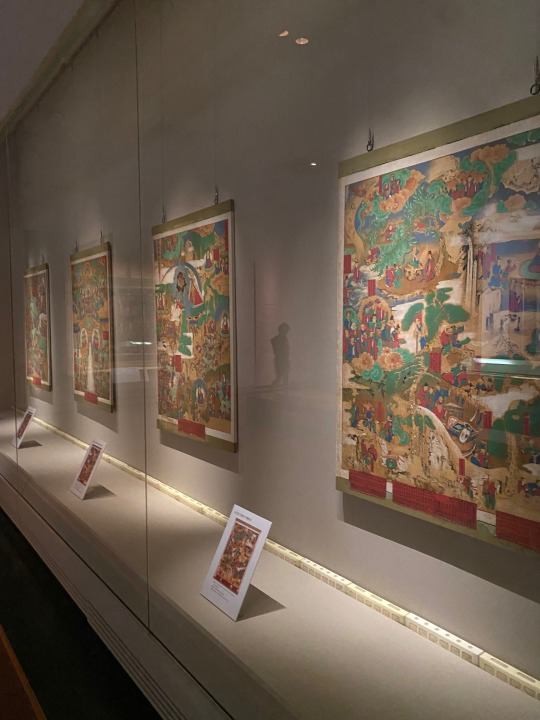

After the museum, I headed to the Seoul airport and caught my flight back to Japan. I experienced and learned a lot of cool things in Korea, and I would love to go back again someday! Also the food there is seriously amazing. 100/10 please try.
Anyway, this concludes my posts about my Korea trip. Thanks as always for reading <3
0 notes
Text
the more i think about it the more convinced i am that Alphen would love Korean food. I want to give that man a big stone bowl of bibimbap with 5 kinds of kimchi and a kilo of gochujang and watch him go to town
#xd#toarise#alphen#I'm gonna have to write a fic of exactly this#He deserves it#Shionne would like it too just with far less gochujang lol
0 notes
Text
We were recently able to get our hands on the Ttukbaegi Pot with Lid 뚝배기 Korean Pot Ramen Pot Stone Clay Pots for Cooking Korean Pot Ceramic Cooking Pot Korean Stone Pot Korean Bowl Onggi Kimchi Pot (Large 30oz) Ttukbaegi Pot with Lid 뚝배기 Claypot and we were excited to give it a review! This pot is made with premium stoneware and has been glaze-fired twice with a natural glaze. It features traditional Korean colors and designs, making it a great choice for those looking to cook Korean delicacies or as a special gift for someone who loves cooking Korean food. The pot can also be used for bibimbap and can keep the food warm and make the rice crispy. Let's dive into this pot and see if it functions as well as it looks!Table of Contents1. Overview of the Ttukbaegi Pot2. Our Experience With the Ttukbaegi Pot3. Is The Ttukbaegi Pot Worth The Investment?Customer Reviews AnalysisPros & ConsFrequently Asked QuestionsUnleash Your True Potential1. Overview of the Ttukbaegi Pot
We were excited to try out the Ttukbaegi Pot with Lid 뚝배기 Claypot. The pot is perfect for cooking delicious Korean dishes such as ramen, rice, soup, egg cusine and many more. The design of the pot is simple yet elegant, with Korean traditional colors and decorations. It also keeps the food warm for a longer period, which is a great bonus. The pot is made from premium stoneware (ceramics), fired twice with a natural glaze for extra durability.
Not only is it perfect for cooking, but it also makes a great gift for anyone who loves Korean food, earthenware, or ttukbaegi. It comes in two sizes, 10oz and 30oz, so you can pick whatever size suits your needs. Surely, this pot is a must-have in any kitchen, not only for its beauty but also for its functionality.2. Our Experience With the Ttukbaegi Pot
We have been using the Ttukbaegi Pot for about a month now, and we are incredibly satisfied with the results. It's made from a premium stoneware, glaze-fired twice with a natural glaze that visibly adds to the aesthetic of the product. It is also decorated with a traditional Korean design, featuring the classic red color. It has a wide range of uses from cooking ramen, rice and soups to making delicious Korean dishes like bibimbap and kimchi.
Cooking with the Ttukbaegi Pot is a real treat. Our food has never tasted better, and the flavors are more intense and robust than before. We love the fact that it keeps our food warm and that the stoneware helps make the rice nice and crispy for bibimbap. While the pot itself is quite large, it's incredibly lightweight and easy to transport. We would highly recommend this product to anyone looking for the perfect clay pot for cooking Korean food. It is also an excellent gift, especially for enthusiastic cooks or those who love Korean culture and cuisine.3. Is The Ttukbaegi Pot Worth The Investment?When it comes to the question of whether or not the Ttukbaegi Pot is worth the investment, the answer is a resounding yes! The pot is exceptionally crafted using the highest quality fine clay and is glaze-fired twice with a natural glaze. The pot is also decorated with a traditional Korean color and design, making it great for bringing an authentic touch to your cooking.
The pot is also incredibly versatile: it can be used for a variety of dishes, from bibimbap to ramen, rice, soup, and egg cuisine. What's more, the pot is specially designed to keep food warm and make rice crispy. Plus, it's a great gift for mothers, grandmothers, and chefs who love traditional Korean cuisine. With its fine craftsmanship and longevity, you can be sure it will last for years to come -- making it a worthwhile investment! Customer Reviews AnalysisCustomer Reviews Analysis
We've gone through the reviews of the Ttukbaegi Pot With Lid 뚝배기 and are pleased to report that the consensus is overwhelmingly positive. Many customers, such as the one quoted above, have highlighted how great this pot is for cooking steamed eggs. They report that it is easy to clean and keeps the eggs nice and hot, making them a great way to start the day.
Other customers have noted that the stone clay construction of this pot makes it an excellent choice for long-term cooking. Whether they're crafting exquisite kimchi, brewing up a simple ramen, or any other tasty treat, this pot is capable of delivering consistently excellent results.
Overall, we're confident that the Ttukbaegi Pot With Lid 뚝배기 is an investment worth making. If you're looking for a reliable pot for all your traditional Korean cooking needs, then this is it! Pros & ConsPros & Cons of Ttukbaegi Pot :
Pros:
The Ttukbaegi pot is the perfect vessel for preparing and cooking traditional Korean food such as ramen, rice, soup, egg cuisine, and more.
Its design is enhanced with the traditional colors and design of Korean pottery, making it a perfect gift for mothers, grandmothers, aunts, and chefs who love authentic Korean pottery.
It is made from a fine clay and glaze-fired twice with a natural glaze, making it durable and reliable.
Widely used for bibimbap stone bowls, as it gives the rice an extra crispy texture and keeps the food warm for longer.
Cons:
The Ttukbaegi pot is liable to cracking if exposed to extreme temperatures, so be mindful of this while using it.
To clean it properly, the pot should not be soaked in water for too long as it could lead to staining.
It is heavy and may be difficult to lift if full. Frequently Asked QuestionsQ&A
Q: What is the Ttukbaegi Pot With Lid 뚝배기?
A: The Ttukbaegi Pot With Lid 뚝배기 is a Korean Pot made of premium stoneware (ceramics) and glaze-fired twice with a natural glaze. It is perfect for cooking Korean cuisine such as ramen, rice, soup, egg cusine, and bibimbap.
Q: Does the pot come with a cover?
A: Yes, it does! The pot comes with a lid decorated with Korean traditional color and design, which makes it great for keeping food warm and crispy.
Q: Is it a good gift for someone?
A: Yes! The Ttukbaegi Pot With Lid 뚝배기 makes a great gift for the Korean food-loving mother, grandmother, ant, or chef in your life. Unleash Your True PotentialWe hope you enjoyed our review of the Korean pot: Ttukbaegi Pot With Lid 뚝배기. If you're interested in trying it out for yourself, you can find it here: https://amazon.com/dp/B09QZJQCS2. Let us know in the comments how you like it!
0 notes
Text
Super cool John: thanks for helping me keep my pattern finder sharp eyes intact to beat the AI machine.
Quality over quantity: in 2018, the AI debate in Bay Area was to know if it could be possible to make accurate ML with less data. In 2023, the LLMs gross horders are too loud, but they can't keep us away to advance our luxury mindset to build our network algorithms with truth and beauty.


Un algorithme est la description d'une suite d'étapes permettant d'obtenir un résultat à partir d'éléments fournis en entrée. Par exemple, une recette de cuisine est un algorithme permettant d'obtenir un plat à partir de ses ingrédients!
"It always seemed wonderfully colorful and complex when a bowl of bibimbap was placed in front of me. I’d get hit with the different colors of all the ingredients, and sometimes the sizzling sound of the rice if it were served in the hot stone pot."
youtube
The pompom eggs are so kawaii kkkk

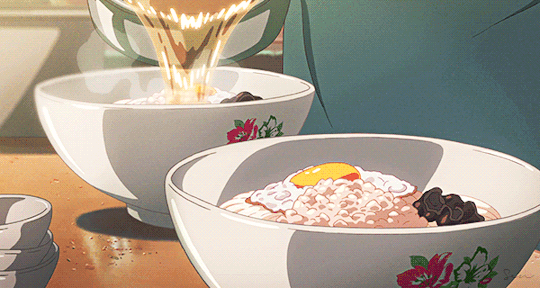
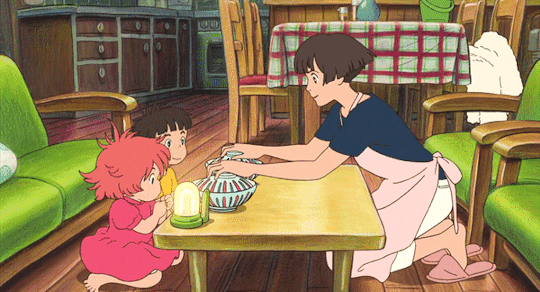
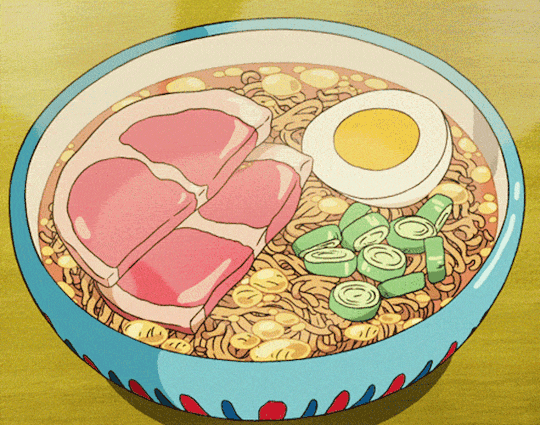
0 notes
Text
Korean Restaurant taon Korean food
Taon Korean Restaurant | Sofitel Abu Dhabi Corniche
With Korean cuisine becoming increasingly popular in Abu Dhabi, a trip to TAON offers an educational (and delicious) insight into the country’s unique culture and dishes.
Friendly and attentive staff dressed in traditional Korean hanbok dresses are knowledgeable about the slightly overwhelmingly in-depth tome of a menu. Ranging from very large dishes like the “whole cow set” to smaller noodle bowls, the menu could well contain any Korean dish you’ve ever heard of.
Recommendations include tangy and spicy kimchi dish to start, which offers a balance of fermented sourness and spice. Warm seafood and scallion pancake has great texture and fragrance, and represents an excellent iteration of Korea’s famed haemul pajeon.
With main dish options including well-known culinary exports such as bulgogi, Korean fried chicken and a whole range of barbecue, you’ll find yourself easily spoilt for choice. Our pick? Hot stone bibimbap, which is an absolute treat for the senses, crammed with sticky, crispy rice, well-seasoned beef and plenty of assorted veg. A warm, cosy dish that doesn’t need saving until winter.
While prices are on the steep side, you really do get what you pay for in portion size, quality and no end to variety. A worthy investment in culinary enjoyment.
Time Out reviews anonymously and pays for its own meals.
Restaurants, Bars & Lounges
Cuisine: Korean
Sofitel Abu Dhabi Corniche - Abu Dhabi - United Arab Emirates
+971 58 682 0030
Open: Closes at 11:00 PM
0 notes